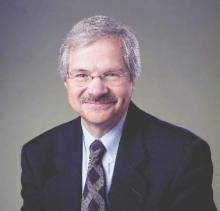BOSTON – More than half a century after the first successful kidney transplant, various new strategies are being pursued to intervene when major organs, such as the heart or kidney, are failing, according to experts at the 2016 AGA Tech Summit, which was sponsored by the AGA Center for GI Innovation and Technology.
Strategies include regenerating tissue and employing artificial devices to perform the function of the failing organ. For tissue regeneration, some of the most promising work is being done in the treatment of the decompensated liver. The unmet need is enormous.
Most patients are not candidates for liver transplant, and those with severe disease have a 30%-50% risk of dying within 90 days of diagnosis, explained Dr. Bill Frank, vice president of medical sciences at Vital Therapies in San Diego. Given the limitations of liver transplantation, he and fellow researchers at Vital Therapies designed an extracorporeal system that continuously delivers a proprietary line of human C3A liver cells. This immortal cell line expresses a number of proteins relevant to liver function, including cytochrome P450 isoenzymes, coagulation factors, growth factors, anti-inflammatory proteins, and anti-apoptotic factors.
The system, called ELAD®, has already been evaluated in a phase III trial conducted in patients with alcohol-induced liver decompensation (AILD). In the study, 203 patients were randomized to ELAD® or usual care. Although those randomized to ELAD® did not have a significantly improved survival at the end of 3 months compared with controls, which was the primary study endpoint, there was a trend toward a survival in benefit in the prespecified subgroups of younger patients (median age 46.9 years) and patients with lower MELD scores (less than 28). In these, the risk of death was reduced by more than 40% (P = .77) and more than 35% (P = .167), respectively.
The outcomes in these subgroups were sufficient for the Food and Drug Administration to permit further clinical trials, and Dr. Frank suggested that this approach remains promising.
“ELAD® treatment has the potential to modulate or reduce the inflammatory response and apoptosis and promote hepatic regeneration,” reported Dr. Frank, noting that it might be used for the treatment of a variety of types of liver decompensation, not just AILD. This includes small-for-size liver, liver damage due to hepatitis C virus (HCV) infection, and even septic liver disease.
A new phase III trial in patients with AILD is anticipated in the first half of 2016, and top-line data are expected by mid-2018, he added. Bringing those interested in GI technology up to speed on a key problem in solid organ transplantation, John J. Sninsky, Ph.D., chief scientific officer at CareDX, Inc. in Brisbane, Calif., reported progress in minimizing key factors involved in graft rejection. This continues to be one of the biggest hurdles in ensuring long-term survival.
“Suboptimal immunosuppressive dosing and the threat of allograft rejection must be balanced with excessive dosing and increased risks of infections and cancer,” Dr. Sninsky said. He described an array of approaches to reduce protein expression or other signals from donor grafts that prompt an immunologic response, but he focused on current initiatives to identify signals of rejection before they produce adverse clinical consequences so immunosuppressive therapy can be adjusted in time.
Of these strategies, cell-free DNA (cfDNA) is intriguing because it is released from dying cells in both the allograft and recipient, and next-generation sequencing can distinguish their respective genomes, Dr. Sninsky said. In a recent longitudinal study of heart and kidney transplant recipients, levels of donor cfDNA rose significantly before biopsy-confirmed transplant rejection. Moreover, donor cfDNA levels dropped after adjustment of immunosuppressive therapy.
“The cfDNA compartment also harbors information about specific infectious diseases and somatic mutations associated with cancer development,” Dr. Sninsky said. Such technology could one day help fulfill a “significant unmet need” for tools to help monitor how patients are responding to transplant, he added.
In the acutely failing kidney, transplantation may not be feasible, but an alternative strategy involving a bioartificial kidney is showing promise in clinical trials, according to Dr. H. David Humes, professor of nephrology, University of Michigan, Ann Arbor. He predicted that such a device might be commercially available sometime in 2017.
Describing the bioartificial kidney as a “renal tubule assist device,” Dr. Humes, who was instrumental in its development, said that living cells are employed to perform their normal filtration activities but also to regulate immune function. Dr. Humes said this extracorporeal device can “buy time” when patients are recovering from an acute insult. In particular, this device is promising for those with renal failure in the intensive care unit, where the mortality associated with this complication is approximately 50%.




